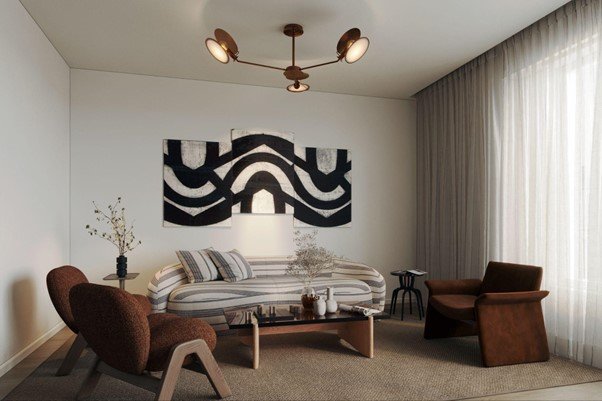Table of Contents
ToggleLandscape Design: The Client's Vision in 3D
Project Overview
This study reports on one of the recent projects undertaken by Ratio Visuals where an interior designer from Boston was our client. This involved the development of a 3D interior view of a modern living room, which the client of the designer needed to see as a part of the ongoing home remodelling process. It was of course that the design was accurately developed to the satisfaction of the client. The designer showed the living room 3d images done by us to the client, so that the latter could understand the space before final design adjustments. In this manner, through 3D visualisation, the materials and furniture chosen were treated fluently by the designer, meeting the detailed requirements of the client.
If we take the time step, the project was completed in four days and this included modifying the camera angle and changing the furniture with high cooperation from the designer. This case study dictates the limitations and advantages of 3D rendering, for both the use of 3D modelling and the interior designer, and follows the workflow from the project description to the result – 3D rendering of the interior.
Client Requirements
The interior designer shared with us a number of items he considered core to the successful execution of the task:
Floor Plan: The floor plan served as the first step in the living room design process, since it provided the arrangement and allocation of spaces needed for the render.

Camera Angle: The designer specified the preferred camera angle she wanted in the rendering, enabling us to show the exact visual that her client would get in the end.

Furniture Links and Mood Board: The client provided a mood board and indicated furniture pieces that she had already selected for the space. Among these were a contemporary couch, some light fixtures, wall decor and a few coffee tables. She, however, had reservations about the choice of the coffee table and therefore wanted the 3D render to assist her client in exploring different variations of coffee tables before settling down on one.




Design Objective: The first and foremost purpose was to make the living room the most modern and pleasing to the eye, which would fit into the atmosphere and taste of the designer’s customer. The model had to be constructed in such a way that would allow rendering of each material, piece of furniture and type of lighting used to achieve a photorealistic representation of the completed project.
The Rendering Process
3D Model Setup: We started off with the incorporation of the floor plans that were given into the 3D modelling software. This particular design of the living room was to be contemporary and stylish and therefore clean lines and proportions were given required consideration while developing the space. Using the furnished links that she shared with us, we modeled or imported the selected furniture to help her visualize it in the right context.
Furniture and Material Application: According to the mood board, we incorporated textures and materials that were appropriate to the vision of the designer. Just as has been designed, the modern aspect required simple colour tones with the majority being in neutral shades, simple textured fabric, and accentuated furniture. Each and every single piece of furniture was mapped with its respective surface textures in order to create realism. For example, the sofa had a soft fabric, and the lampshade an elegant finish of metallic material casing.
Lighting and Ambiance: Lighting is considered one of the primary aspects of the interior renders as they dictate how the space feels. We revised the adjustments in the lighting in accordance with the day and atmosphere that the designer wanted to achieve. The living room had large windows, which therefore means that we used softened daylight to light the space and bring out the materials and furniture arrangement.
Camera Angle Confirmation: We also provided a screenshot of the 3D model to the designer showing the camera angle and the furniture layout to ensure the orientation was correct prior to proceeding with the latest render. Such a step is necessary in our workflow so that if any changes need to be made, they can be done in the early stages of the creation process. The shot was good to the designer, but she wanted to confirm all the pieces of the furniture were right as concerns the coffee table which she had not decided on.

Revisions and Final Render: We noted the comments regarding the camera angle and the choice of the accompanying furniture pieces and carried out the final render. The render used in this case was majorly success driven, focusing mainly on the spatial arrangement, the texture and the shadows interacting with the light in the room. The last stage which was the delivery of the render was done and it was well received by the client who was left fully satisfied with the work done.

Project Result
The designer was indeed satisfied with the results of the commissioning and most importantly the 3d living room visualisation helped the client understand the concept better. The 3d render was equally convincing showing the clients how the end product will be so that they request the designer to commence working on the same.
This work was finished in the four calendar days allotted, proving our ability to produce quality renders in a short period with space limitation. The designer valued the ease and relief rendered by the render which in turn enhanced the overall presentation of the design as it had a professional touch to it.
Reasons Why Interior Designers Should Utilise 3D Renderings
As seen in this project, 3D rendering is a very helpful aid in the field of interior design. It has several merits which in one way or another can help enhance the design phase as well as the satisfaction of the client.
Material and Furniture Selection: Interior designers encounter limitations when consideration is given to the selection of materials and furniture for their designs. Even with mood boards and design silhouettes, a client may still find it hard to conceive how the different components will be set up in a room. 3D rendering closes this gap by enabling the rendering of the design as it would look like at completion.
For instance, in this case, the designer seems undecided about the coffee table and wishes to look at various alternatives and gauge the context. The 3D render helped her see how the coffee table would fit in with the other furniture and the arrangement of the whole room. This kind of information adds to the type of decisions that are made and helps in developing the deliverable as per the clients’ requirements.
Enhanced Presentation and Client Communication: There are boundaries to how much 2D drawings and mood boards can impress clients during a design presentation. Further, 3D renderings of the space are provided so that clients can comprehend the range of elements incorporated by the designer without having to imagine the setup.
In this project, the designer was able to use the render in order to show the living room design to her client and help them understand the layout and colors as well as the furniture rather than the boring 2D renderings. Such a render enables the client to interact with the design even before its physical realisation, enhancing their assurance about the design and expediting the processes of getting approval.
Time Savings and Efficiency: It can be noted that even with the complexities of the project and construction timeline, the 3D rendering helps to get potential problems out of the way. Such valuable time may save the company even prevent errors that may be costly to deal with in the execution phase.
As for the Boston project, the designer has managed to modify her choices and get approval of all the details from her client within a very short time before commencement of the actual work. This reduced the time to come up with the overall design as the client was in a position to make quicker decisions thus less changing would be needed later on.
Impressing Clients: Designers are well aware that simply designing a space is not enough in current competition therefore additional steps and incentives are needed to satisfy clients. Photorealistic 3D renders can add a new touch to the design presentation helping create a WOW factor that will assist the clients see and fall in love with the space being designed thus they are more likely to approve the projections.
The rendering produced for the Boston based designer’s client impressed him, and the project goes into the execution phase after receiving approval. The clarity, meticulous detailing, and realism with which the lighting and materials were illustrated created a niche in the designer’s proposal that made sure the project was going straight on without any stops.
Conclusion
This interior 3D rendering project of the Boston based interior designer’s stile demonstrated benefits of 3d rendering. This binding representation of designs enables not only material and furniture selection but also saves time in client presentation enhancing workflow in the processes.
Here at Ratio Visuals, our focus is on targeting interior designers through high quality 3D renderings of their design intent. The outcomes of our work not only stress the process of design but the client’s wow factor is also optimised, with most futuristic and impressive designs being offered to them by the designers. Whether running a residential or commercial project, our team is ready to listen to your design needs and enhance the appeal of your presentations with realistic looking 3D render images.

